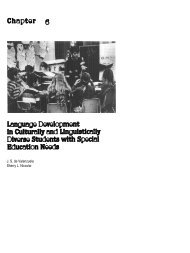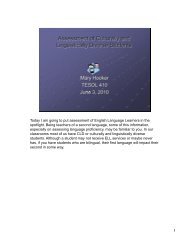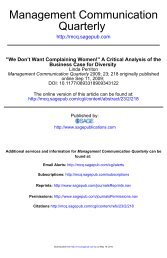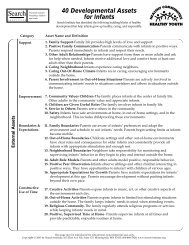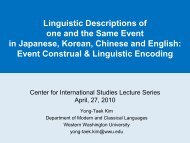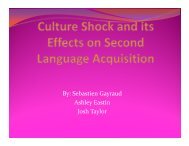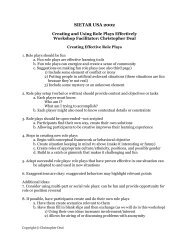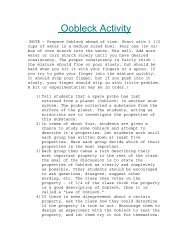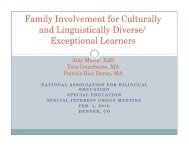Multicultural Special Education
Multicultural Special Education
Multicultural Special Education
You also want an ePaper? Increase the reach of your titles
YUMPU automatically turns print PDFs into web optimized ePapers that Google loves.
Intervention in School and Clinic<br />
http://isc.sagepub.com<br />
<strong>Multicultural</strong> <strong>Special</strong> <strong>Education</strong>: Effective Intervention for Today's Schools<br />
Festus E. Obiakor<br />
Intervention in School and Clinic 2007; 42; 148<br />
DOI: 10.1177/10534512070420030301<br />
The online version of this article can be found at:<br />
http://isc.sagepub.com/cgi/content/abstract/42/3/148<br />
Published by:<br />
Hammill Institute on Disabilities<br />
and<br />
http://www.sagepublications.com<br />
Additional services and information for Intervention in School and Clinic can be found at:<br />
Email Alerts: http://isc.sagepub.com/cgi/alerts<br />
Subscriptions: http://isc.sagepub.com/subscriptions<br />
Reprints: http://www.sagepub.com/journalsReprints.nav<br />
Permissions: http://www.sagepub.com/journalsPermissions.nav<br />
Downloaded from http://isc.sagepub.com at WESTERN WASHINGTON UNIV on November 25, 2008
<strong>Multicultural</strong> <strong>Special</strong> <strong>Education</strong>:<br />
Effective Intervention for Today’s Schools<br />
FESTUS E. OBIAKOR<br />
In this era of accountability, schools are challenged to leave no child behind,<br />
which includes making schools more responsive to students’ needs.<br />
For many multicultural learners, the noble ideal of leaving no child behind<br />
has not yielded the desired dividends in general and special education. The<br />
processes of identification, assessment, categorization, placement, and instruction<br />
have tended to downplay their cultural and linguistic differences.<br />
This article focuses on multicultural special education as an effective intervention<br />
for today’s schools.<br />
Richardo was a 9-year-old Hispanic American student who<br />
had lived in the United States for 5 years. He attended a<br />
“good” school where the focus was on achieving higher test<br />
scores. Although his family spoke primarily Spanish in<br />
the home, Richardo spoke English moderately well. Peers<br />
frequently ridiculed his English—they felt he was not<br />
“smart” because of his slight accent—and he had difficulty<br />
relating to them. Classmates consistently used negative<br />
words to describe Richardo. Richardo’s parents had tried<br />
working with the classroom teacher; however, she appeared<br />
to not understand their concerns regarding their son.<br />
Indeed, on one occasion, the teacher noted that “Richardo<br />
is trouble and does not get along with his peers.” Eventually,<br />
Richardo was referred by this teacher for standardized<br />
testing for behavior disorders. The night before<br />
the assessment, Richardo’s dog was hit by a car and killed.<br />
He was sad and in poor spirits; yet he was assessed as<br />
scheduled even though his parents notified the school. The<br />
school psychologist, who spoke no Spanish, was late for administering<br />
Richardo the tests because of car problems on<br />
the way to school. The tests were administered in her small<br />
office, a place unfamiliar to Richardo. Finally, the test<br />
scores were compared to Anglo norms.<br />
Richardo was labeled as having behavior disorder and<br />
placed in a special education program. Variables such as<br />
cultural differences, academic background, ability to<br />
speak and understand English, negative peer behavior,<br />
the general education teacher’s lack of understanding,<br />
Richardo’s emotional reaction to losing his pet, and the examiner’s<br />
demeanor were not considered in the identification<br />
and assessment of behavior disorders for this student.<br />
<strong>Multicultural</strong> learners like Richardo are increasingly<br />
common in today’s public schools. According<br />
to the National Center for <strong>Education</strong> Statistics<br />
(2001) and the U.S. Department of <strong>Education</strong> (2001), there<br />
appears to be some disproportion in the general public<br />
school enrollments and special education placements for<br />
minority groups. For instance, though Anglo Americans<br />
represent about 67% of general public school enrollments,<br />
148 INTERVENTION IN SCHOOL AND CLINIC VOL. 42, NO.3,JANUARY 2007 (PP. 148–155)<br />
Downloaded from http://isc.sagepub.com at WESTERN WASHINGTON UNIV on November 25, 2008
they represent about 43% of special education placements.<br />
On the other hand, although African Americans<br />
represent about 17% of general public school enrollments,<br />
they represent about 20% of special education placements.<br />
From 2000 through 2001, there was a national student<br />
population of 67% Anglo American, 17% African American,<br />
16% Hispanic, 4% Asian/Pacific Islander, and 1%<br />
American Indian/Alaska Native. However, special education<br />
placement of these groups was disproportionate in<br />
terms of the racial/ethnic composition of students: 43%<br />
Anglo American, 20% African American, 14% Hispanic,<br />
2% Asian/Pacific Islander, and 1% American Indian/<br />
Alaska Native (U.S. Department of <strong>Education</strong>, 2001).<br />
Even with this increase in student diversity, “the cultural<br />
gap between the current school age population and the<br />
teaching pool is widely recognized” (Kozleski, Sobel, &<br />
Taylor, 2003, p. 75). In other words, the changing student<br />
demography in general and in special education programs<br />
has not truly reflected changes in the teaching force. It is<br />
no surprise that there is sometimes a disconnect between<br />
what multicultural learners bring to the classroom and<br />
what their Anglo American peers and teachers bring to<br />
the classroom.<br />
Richardo’s case demonstrates the traditional teaching–<br />
learning situations in which some multicultural learners<br />
find themselves. To a large measure, it reveals unintended<br />
consequences associated with the current selection process<br />
for special education, which sometimes leads to<br />
misidentification, misassessment, miscategorization, misplacement,<br />
and misinstruction or misintervention (Grossman,<br />
2002; Obiakor, 2001, 2003). While the overall goal<br />
in the classroom was to assist Richardo, the unintended<br />
consequence was ultimate exclusion from the general education<br />
environment.<br />
Richardo<br />
Richardo’s negative experience might stem from one “bad”<br />
teacher; however, many students from different racial,<br />
cultural, linguistic, and socioeconomic backgrounds find<br />
themselves in school programs that appear to downplay<br />
strengths while highlighting supposed weaknesses (Banks,<br />
2002; Guinier, 2002; Henze, Katz, Norte, Sather, &<br />
Walker, 2002; Obiakor & Ford, 2002). To effectively discuss<br />
Richardo’s case and present multicultural special education<br />
as an effective intervention for today’s schools, it<br />
is important to start by analyzing his classroom/school<br />
experiences within the context of the selection process for<br />
special education (i.e., identification, assessment, categorization,<br />
placement, and instruction).<br />
Identifying Richardo<br />
Is it possible that Richardo’s classroom situation warranted<br />
his teacher’s attention? Maybe he deserved attention that<br />
would have maximized his potential in the classroom. He<br />
had a linguistic difference, not a linguistic deficiency, as<br />
his classmates or teacher assumed. Clearly, identifying<br />
Richardo as a problem student set the stage for further<br />
legally mandated activities not routinely addressed in general<br />
education classrooms. Once a student has been identified<br />
as having an educational problem, the laws (e.g.,<br />
<strong>Education</strong> for All Handicapped Children Act of 1975, Individuals<br />
with Disabilities <strong>Education</strong> Act of 1990, and the<br />
IDEA Amendments of 1997) mandate that teachers employ<br />
several interventions before the testing phase. It appears<br />
that Richardo’s teacher did not empower his parents<br />
or engage them in any form of due-process collaboration<br />
needed to ensure a successful learning experience for<br />
him. Before Richardo was recommended for assessment,<br />
multiple sources of information (e.g., classroom observations<br />
of how Richardo interacted with his classmates or<br />
how he performed in classroom activities) should have been<br />
examined.<br />
Grossman (2002) and Sbarra and Pianta (2001) agreed<br />
that teachers judge ethnic minority and low-income students’<br />
behaviors as more deviant than those of wealthier<br />
Anglo American children. They also noted that these<br />
perceptions are due to cultural biases of teachers. Parents<br />
generally trust and rely on general and special educators<br />
to detect various disabilities; however, some teachers play<br />
on the subjective nature of the current system and abuse<br />
the initial referral process by selectively excluding those<br />
who they deem as different (Skrtic, 2003; Utley & Obiakor,<br />
2001). Another question is whether it is possible<br />
that Richardo’s parents concerns were ignored by the<br />
teacher because of their cultural and linguistic differences.<br />
All parents must be empowered and viewed as equal partners<br />
if their children are to be helped (Fletcher & Bos,<br />
1999).<br />
Assessing Richardo<br />
The key terms in education today are accountability and<br />
evidence-based practices (see the National Research Council’s<br />
2002 report and the No Child Left Behind Act of<br />
2001). Assessment is not only a part of accountability, it<br />
is also an integral part of the teaching–learning process.<br />
However, tools historically used to assess culturally and<br />
linguistically diverse learners have been fraught with problems<br />
of reliability and validity (Guinier, 2002; Karp, 2002;<br />
Karr & Schwenn, 1999; Obiakor, 1999; Skrtic, 2003). In<br />
Richardo’s case, the reasons for referral are unclear. Was<br />
he referred for assessment because he could not get along<br />
with his peers? Or was he referred because the teacher<br />
wanted to exclude him from the general education classroom?<br />
One thing is clear—many variables are intertwined<br />
in Richardo’s assessment situation.<br />
Grossman (2002) and Karr and Schwenn (1999) suggested<br />
that a more comprehensive, holistic model of assessment<br />
must be used to avoid miscategorizing students.<br />
VOL. 42, NO.3,JANUARY 2007 149<br />
Downloaded from http://isc.sagepub.com at WESTERN WASHINGTON UNIV on November 25, 2008
Multiple voices and multiple perspectives from Richardo’s<br />
school and home environments would have been beneficial<br />
to him. Specifically, to help Richardo to maximize his<br />
potential, his assessment should have been (a) instructionally<br />
related, (b) operational and functional, (c) authentic<br />
and realistic, (d) multidimensional and nondiscriminatory,<br />
(e) nonjudgmental and meaningful, (f) responsive to interand<br />
intraindividual differences, (g) consultative and collaborative,<br />
and (h) germane to culture, race, environment,<br />
and language (Langdon, 2002; Obiakor, 2001, 2003). Assessment<br />
must be measurable, devoid of emotion, and<br />
used to make goal-directed decisions in school programs.<br />
Categorizing Richardo<br />
Was it appropriate to categorize Richardo as having behavior<br />
disorders because he could not get along with<br />
classmates who made fun of his linguistic difference? His<br />
classroom problem presents the traditional ambiguity regarding<br />
criteria for categorical labeling in general and<br />
special education. Often, biased general and special educators<br />
predict doom for some multicultural learners who<br />
fail to conform to their unidimensional standards (Grossman,<br />
2002; Guinier, 2002; Rothenberg, 2002; Weiss, 2002;<br />
Wise, 2002). For example, in his classic work, Hobbs<br />
(1975) noted that words and labels are necessary to classify<br />
students, but that they make victims of students. As<br />
he pointed out:<br />
Categories and labels are powerful instruments for social<br />
regulation and control, and they are often employed for<br />
obscure, covert, or hurtful purposes: to degrade people, to<br />
deny their access to opportunity, to exclude “undesirables”<br />
whose presence in some way offends, disturbs familiar custom,<br />
or demands extraordinary effort. (p. 11)<br />
Invariably, categories and labels negatively force<br />
students to make inaccurate assumptions about their abilities<br />
(see Obiakor, 1999). In addition, they force students<br />
to internalize this self-fulfilling prophecy (i.e., individuals<br />
act according to their assigned labels). Hobbs’ (1975)<br />
views were later reiterated by Ysseldyke, Algozzine, and<br />
Thurlow (2000) when they wrote:<br />
Despite a presumed need for them, labels are an unfortunate<br />
by-product of a system that attaches money to acts,<br />
thus resulting in classifications and categories. Labels are<br />
often irrelevant to the instructional needs of students.<br />
Furthermore, labels become real attributes that prevent<br />
meaningful understanding of actual individual learning<br />
needs. By causing some to believe that students labeled as<br />
having mental retardation cannot perform certain tasks,<br />
the act of classifying condemns these students to a life of<br />
lesser expectations and performance. Labels require official<br />
sanction. Resources diverted to the process of identifying<br />
and classifying students are extensive. Time and<br />
money spent on labeling are time and money not spent on<br />
teaching. Time spent being labeled is time not spent on<br />
being taught or learning. (p. 11)<br />
Placing Richardo<br />
In some cases, placements assist general and special education<br />
professionals in designing appropriate programs<br />
for persons with special needs. In Richardo’s case, was his<br />
special education placement geared toward helping him<br />
to maximize his potential? Or was it geared toward excluding<br />
him from the general education classroom?<br />
Clearly, he was tracked for exclusion. Because of problems<br />
associated with Richardo’s identification, assessment,<br />
and categorization, it is unclear whether his exclusion<br />
from the general education classroom will be helpful to<br />
him. As Ysseldyke et al. (2000) noted, “Placement issues<br />
have a broader base than just those individuals with disabilities.<br />
The jump from special education segregation to<br />
teaching (in grouping) students by their implied level is<br />
not a huge leap, and the effects of tracking have been<br />
noted repeatedly” (p. 135).<br />
An appropriate placement for Richardo must be based<br />
on his needs and not on racial and cultural identities. Invariably,<br />
where a student like Richardo is placed depicts<br />
how much value is placed on him. Critical to education<br />
today are issues of overrepresentation of culturally diverse<br />
learners in special education programs (e.g., programs<br />
for students with emotional/behavioral disorders)<br />
and underrepresentation of these students in programs for<br />
students with gifts and talents (Artiles, 1998; Cartledge,<br />
Tillman, & Talbert-Johnson, 2001; Coutinho, Oswald, &<br />
Forness, 2002; Ford, 1998; Obiakor et al., 2002, 2004;<br />
Skiba, Simmons, Ritter, Kohler, & Wu, 2003). Following<br />
are important placement principles for general and special<br />
education professionals:<br />
• Race and culture matter in the placement of students.<br />
• Placements must be based on students’ need and not<br />
on racial and cultural identities.<br />
• Language difference should never be misconstrued as<br />
a lack of intelligence.<br />
• Empathy is an important ingredient of “good”<br />
placement.<br />
• Good placements are usually least restrictive<br />
environments.<br />
• Differences are not deficits.<br />
• Students are best served when their due-process<br />
rights are respected.<br />
• Appropriate inclusion reduces biased exclusion of<br />
students in classroom activities.<br />
• Prejudicial placements have devastating effects on<br />
students.<br />
• The unique differences brought by students into<br />
classrooms must be valued.<br />
150 INTERVENTION IN SCHOOL AND CLINIC<br />
Downloaded from http://isc.sagepub.com at WESTERN WASHINGTON UNIV on November 25, 2008
Instructing Richardo<br />
Did Richardo’s classroom teacher help him to maximize<br />
his potential? In what kind of classroom did Richardo<br />
find himself? It is important that teachers create instructional<br />
environments that promote academic productivity<br />
and appropriate social behaviors for an increasingly diverse<br />
student population. Richardo could have been<br />
helped by a broad range of strategies useful in designing,<br />
implementing, and evaluating instruction. He needed<br />
opportunities to attain new skills and activities. Instructional<br />
strategies for Richardo should have included<br />
• taking in a holistic view of his instruction (i.e., valuing<br />
the kind of instruction that uses multiple<br />
variables);<br />
• having equity as a big picture in his classroom (i.e.,<br />
incorporating human respect in classroom activities);<br />
• monitoring of his success (i.e., finding out if learning<br />
is occurring);<br />
• engaging him and his classmates in small-group<br />
discussion and cooperative learning (i.e., enhancing<br />
collaboration and consultation in classroom<br />
activities);<br />
• sequencing and organizing his instruction (i.e., trying<br />
to manipulate learning environments);<br />
• engaging him in higher-level thinking (i.e., practicing<br />
critical thinking);<br />
• having adequate goals, standards, and outcomes for<br />
his instruction (i.e., making sure instruction responds<br />
to individual needs);<br />
• understanding his classroom and school milieu (i.e.,<br />
moving beyond acceptance to acclimatization in classroom<br />
and school activities);<br />
• managing his classroom environment (i.e., making<br />
sure classrooms are not disruptive); and<br />
• providing him with positive school outcomes (i.e.,<br />
making sure school is rewarding; see De La Paz,<br />
1999; Obiakor, Utley, & Rotatori, 2003; Orlich,<br />
Harder, Callahan, & Gibson, 2001).<br />
Appropriate instruction is not totally divorced from<br />
the identification, assessment, categorization, and placement<br />
of students. For Richardo, interaction with his peers<br />
in the classroom led to some negative learning–teaching<br />
processes. For instruction to be appropriate for students<br />
like Richardo, general and special education teachers<br />
must<br />
• know each student;<br />
• learn the facts about each student when in doubt;<br />
• challenge the thinking of each student;<br />
• use resources and staff to assist each student;<br />
• build each student’s self-concepts;<br />
• teach each student using different techniques, as appropriate;<br />
• make the right choices based upon “new” knowledge<br />
about each student; and<br />
• continue to learn how to help each student to grow.<br />
It is important that general and special education<br />
teachers (a) educate themselves about things they do not<br />
know; (b) use creative ideas to develop classroom interactions;<br />
(c) create an atmosphere that welcomes parents,<br />
students, and staff; (d) be knowledgeable about different<br />
teaching modes; and (e) put individual students in a positive<br />
learning environment.<br />
Making <strong>Multicultural</strong> <strong>Special</strong><br />
<strong>Education</strong> Functional<br />
Imagine how boring this life would be if everybody had<br />
one skin color, if everybody belonged to one race, one<br />
gender, one religion, one language, one culture, and one<br />
nation. In fact, imagine how boring it would be if everyone<br />
ate the same food, drove the same cars, wore the same<br />
clothes, built the same houses, danced to the same music,<br />
had the same kings and queens, and lived in the same<br />
homes. Differences and divisions have always existed<br />
among human beings; however, how these differences<br />
and divisions are valued and incorporated in inclusive<br />
school programs presents challenges (Arthur, 2000; Banks,<br />
2002; Boykin, 2000; Guinier, 2002; Karp, 2002; Rothenberg,<br />
2002; Weiss, 2002; Wise, 2002).<br />
Using Richardo’s case as an example, there is a strong<br />
relationship between students’ languages or cultures and<br />
how they are dealt with in general and special education.<br />
VOL. 42, NO.3,JANUARY 2007 151<br />
Downloaded from http://isc.sagepub.com at WESTERN WASHINGTON UNIV on November 25, 2008
How are multicultural differences addressed in general<br />
and special education? How do culture and language relate<br />
to multicultural special education? To adequately<br />
answer questions, one must understand multicultural education,<br />
how language valuing or devaluing affects special<br />
education, and how all these variables are tied to<br />
multicultural special education.<br />
Understanding <strong>Multicultural</strong> <strong>Education</strong><br />
<strong>Multicultural</strong> education is not just a study of exotic groups;<br />
it is a force worthy of complementing major theoretical<br />
frameworks like humanistic education, behavioristic education,<br />
and cognitive education approaches (Smith, Richards,<br />
MacGranley, & Obiakor, 2004). It is no wonder that<br />
multicultural education is infused into existing educational,<br />
psychological, counseling, and sociological programs.<br />
Earlier in his classic work, Dewey (1958) acknowledged<br />
that “education must have the tendency, if it is education,<br />
to form attitudes” (p. 56). His views have been corroborated<br />
by many scholars and educators (see Banks, 2002;<br />
Guinier, 2002; Karp, 2002; Obiakor, 2003; Rothenberg,<br />
2002; Sparks, 1999; Utley & Obiakor, 2001; Weiss, 2002;<br />
Wise, 2002), who have noted the need for the nation’s<br />
citizens to develop cultural, linguistic, and ethnic valuing<br />
to revamp school and societal thinking. <strong>Multicultural</strong> education<br />
taps into the human resources of all Americans<br />
and ascertains that educational and vocational options<br />
and opportunities are provided for all.<br />
Clearly, multicultural education has an equalizing<br />
effect on traditional general and special education because<br />
it aims at maximizing the potential of all learners, in<br />
spite of cultural and linguistic differences, national origins,<br />
and socioeconomic backgrounds (Brantlinger & Roy-<br />
Campbell, 2001; Gollnick & Chinn, 2002; Smith et al.,<br />
2004). Whether students are in general or special education<br />
programs, multicultural education inspires teachers<br />
and service providers to<br />
• value students’ cultures, languages, national origins,<br />
and socioeconomic backgrounds by welcoming them<br />
in school programs;<br />
• stimulate students intellectually by providing them<br />
with more novel ideas;<br />
• assist students in maximizing their potential by<br />
understanding their strengths and weaknesses;<br />
• create nurturing environments for students by<br />
empowering them;<br />
• collaborate and consult with students’ parents by<br />
regarding them as equal partners; and<br />
• provide support mechanisms for students’ growth and<br />
development by playing many roles in their lives.<br />
Language Valuing/Devaluing<br />
and <strong>Special</strong> <strong>Education</strong><br />
Language is an integral part of classroom instruction, just<br />
as it is an integral part of culture. For many multicultural<br />
learners (e.g., Hispanic Americans as in Richardo’s case),<br />
“language is a complex and unique characteristic of their<br />
culture. Hispanic Americans exhibit variants in terms of<br />
native language use, bilingualism, or English language<br />
proficiency” (Delgado & Rogers-Adkinson, 1999, p. 57).<br />
Clearly, general and special educators must understand<br />
their students’ linguistic skills to evaluate the type or extent<br />
of educational provisions needed. Going back to<br />
Richardo, he was proficient in the Spanish language and<br />
was learning to be proficient in the English language, the<br />
language of instruction. He was a bilingual student or<br />
second-language learner who functioned in a monolingual<br />
and monocultural classroom environment. According to<br />
Delgado and Rogers-Adkinson, “Many Hispanic-American<br />
students come to school with different experiences than<br />
the majority of children. Several factors that may influence<br />
the child’s performance in the classroom must be<br />
considered before formal assessment is initiated” (p. 62).<br />
In many urban, suburban, or rural schools, students<br />
come to school with many different cultural languages<br />
that conflict with the official standard English used in<br />
classroom instructions. Some African American children<br />
speak Ebonics as they interact in classrooms (Smitherman,<br />
2001; Williams, 1975). While this language is a nonstandard<br />
English, many experienced teachers have been able<br />
to utilize it in classroom instruction without diluting their<br />
152 INTERVENTION IN SCHOOL AND CLINIC<br />
Downloaded from http://isc.sagepub.com at WESTERN WASHINGTON UNIV on November 25, 2008
focus on mastering the official standard English (Craig &<br />
Washington, 2000). For instance, rap music and hip hop<br />
music have a strong poetic or Ebonic influence that psychologically<br />
engages urban, suburban, or rural youth in<br />
today’s changing society. Consequently, labeling students<br />
who use Ebonics as having linguistic deficiency can lead<br />
to academic disengagement and behavior problems. When<br />
these behavior problems are inappropriately addressed,<br />
students may drop out of school and begin engaging in<br />
antisocial behaviors and criminal activities (e.g., drug dealing)<br />
that may eventually land them in jail. Put another<br />
way, language and cultural valuing enhances academic<br />
engagement and student retention and graduation and<br />
makes possible a productive life.<br />
Similarly, many students in urban schools come from<br />
immigrant Chinese, Japanese, Korean, or Hmong families<br />
that speak a language at home that is different from<br />
the language spoken at school (Chang, Lai, & Shimizu,<br />
1999). As a result, Asian and Pacific American students<br />
experience missed learning opportunities, especially when<br />
school practices are not properly organized to meet their<br />
needs. Chang et al. addressed the “model student” myth<br />
(i.e., the assumption that all Asian and Pacific American<br />
students are brilliant and gifted) as a critical problem in<br />
general and special education. They argued that instead<br />
of making unwarranted assumptions about these students,<br />
teachers and service providers must (a) take advantage of<br />
students’ prior knowledge, (b) identify students’ multiple<br />
abilities, (c) use multifaceted teaching techniques, and<br />
(d) utilize parents/guardians as learning resources.<br />
In addition, there are foreign-born African Americans<br />
who have immigrated willingly to the United States from<br />
African and Caribbean nations (e.g., Nigeria, Jamaica,<br />
Haiti). Many of these immigrants speak different languages<br />
(e.g., Igbo, Hausa, Yoruba, Patua) at home and speak<br />
English outside their homes. However, they may speak<br />
English with noticeable accents (Arthur, 2000; Obiakor<br />
& Grant, 2002). In many cases, children of these immigrants<br />
encounter prejudice in school programs because of<br />
their linguistic differences, cultural backgrounds, and national<br />
origins (e.g., Lau v. Nichols, 1973). Interestingly,<br />
many of these children excel academically despite their<br />
differences.<br />
<strong>Multicultural</strong> <strong>Special</strong> <strong>Education</strong>:<br />
The Reality of Change in Schools<br />
<strong>Multicultural</strong> special education represents a realistic view<br />
of change needed as an integral part of general education<br />
(Utley & Obiakor, 2001; Winzer & Mazurek, 1998). It<br />
guarantees respect for multicultural education, general<br />
education, special education, and bilingual education.<br />
In addition, it highlights the positive relationship between<br />
important educational and societal variables in the<br />
teaching–learning process. In the words of Winzer and<br />
Mazurek:<br />
<strong>Special</strong> education can no longer be concerned solely with<br />
the nature of a disabling condition and appropriate intervention<br />
strategies tailored for a particular disability. With<br />
the composition of the school-aged population shifting to<br />
encompass more students from culturally diverse backgrounds,<br />
bilingual homes, and economically disadvantaged<br />
families, the need for special services in the schools<br />
increases, and special educators must consider a broader<br />
range of characteristics that specifically include (but are<br />
certainly not restricted to) cultural and linguistic difference.<br />
Today and in the future, schools must develop programs,<br />
teaching methods, and resources to teach a diverse<br />
body and improve special education service delivery for exceptional<br />
learners from a wide variety of cultural and linguistic<br />
backgrounds. (p. 1)<br />
An analysis of Winzer and Mazurek’s statement reveals<br />
why general and special educators and multicultural<br />
and bilingual educators share a similar mission of helping<br />
culturally and linguistically diverse learners to optimize<br />
their potential. In other words, multicultural special education<br />
encompasses educational programming that helps<br />
all learners who are at risk for misidentification, misassessment,<br />
miscategorization, misplacement, and misinstruction<br />
because of their racial, cultural, and linguistic<br />
differences.<br />
Looking at Richardo’s case, there is every indication<br />
that his teacher, even with the best intention, lacked the<br />
knowledge needed to work with multicultural learners.<br />
With proper education and preparation, the teacher would<br />
have<br />
• made sure that all students, including Richardo,<br />
are treated equitably without losing the intended<br />
quality;<br />
• respected Richardo’s linguistic difference while motivating<br />
him to learn the second language;<br />
• recognized that linguistic difference does not mean<br />
linguistic deficit;<br />
• infused social justice and mutual respect for all students<br />
in her class;<br />
• focused on well-planned cooperative learning between<br />
Richardo and his classmates;<br />
• empowered Richardo’s parents to participate as equal<br />
partners in class;<br />
• desisted from referring Richardo for special education<br />
assessment (in the end, Richardo’s negative experiences<br />
would have been avoided);<br />
• utilized a bilingual educator or a translator in<br />
Richardo’s instructions (all students would have<br />
benefited from the presence of a bilingual personnel);<br />
• utilized not just Richardo’s parents but also other<br />
VOL. 42, NO.3,JANUARY 2007 153<br />
Downloaded from http://isc.sagepub.com at WESTERN WASHINGTON UNIV on November 25, 2008
members of the Hispanic community in her interactions<br />
with Richardo; and<br />
• learned how behavior disorder does not occur in isolation<br />
(e.g., Richardo’s interaction with his classmates<br />
led to his referral, which ultimately led to his assessment,<br />
categorization, and placement in special<br />
education).<br />
Based on the aforementioned ideas accumulated<br />
from Richardo’s classroom experiences, it is reasonable to<br />
conclude that<br />
• <strong>Special</strong> education works when it is connected to a<br />
free and appropriate public education for all learners,<br />
including those from multicultural backgrounds.<br />
Legally, all learners must receive a free education<br />
appropriate to their needs.<br />
• <strong>Special</strong> education works when multicultural learners<br />
are not misidentified. Legally, all learners must be<br />
identified and referred without prejudice.<br />
• <strong>Special</strong> education works when multicultural learners<br />
are not assessed discriminately. Legally, assessments<br />
must be nondiscriminatory to all learners.<br />
• <strong>Special</strong> education works when multicultural learners<br />
are afforded procedural safeguards, including due<br />
process. Legally, the civil rights of all learners must<br />
be protected.<br />
• <strong>Special</strong> education works when parents of multicultural<br />
learners are empowered and treated as equal<br />
partners. Legally, the parents and guardians of all<br />
learners must be contacted by the school during the<br />
special education process.<br />
• <strong>Special</strong> education works when confidentiality of information<br />
is maintained for multicultural learners.<br />
Legally, information about all learners must be kept<br />
confidential and not openly discussed in places such<br />
as faculty lounges.<br />
• <strong>Special</strong> education works when multicultural learners<br />
are educated in least restrictive environments.<br />
Legally, indiscriminate inclusion or exclusion of all<br />
learners must be avoided.<br />
• <strong>Special</strong> education works when Individualized <strong>Education</strong><br />
Programs are based on (a) multicultural learners’<br />
needs, (b) the collaboration and consultation of team<br />
members, and (c) culturally responsive strategies.<br />
Legally, a team of professionals and the parents must<br />
work together to address programmatic needs of all<br />
learners.<br />
• <strong>Special</strong> education works when accountability does not<br />
discriminate against multicultural learners. Legally,<br />
schools must be accountable for the education of all<br />
learners.<br />
• <strong>Special</strong> education works when it is not connected to<br />
illusory conclusions and prejudicial expectations that<br />
demean multicultural learners. Legally, acceptable<br />
categories must be used with all learners.<br />
Conclusion<br />
This article espouses the importance of multicultural special<br />
education in today’s changing schools. Students like<br />
Richardo deserve an educational environment that gives<br />
them the opportunity to grow. In addition, they deserve<br />
general and special education teachers who understand<br />
the relationship between language, culture, and learning.<br />
The issue is not whether Richardo’s teacher was good or<br />
bad; the issue is whether she was prepared for the complexities<br />
of today’s multicultural classrooms. <strong>Special</strong> education<br />
is necessary to maximize the potential of learners<br />
with exceptionalities. While there are legal obligations<br />
involved in working with these learners, the focus must<br />
be on doing what is right for them. <strong>Special</strong> education<br />
must be valued as an important educational phenomenon<br />
that works when general and special educators nurture<br />
different human intelligences, challenge their own perspectives,<br />
and incorporate multicultural voices as they<br />
resolve traditional problems confronting students like<br />
Richardo in their respective programs.<br />
ABOUT THE AUTHOR<br />
Festus E. Obiakor, PhD, is a professor in the Department of<br />
Exceptional <strong>Education</strong> at the University of Wisconsin–<br />
Milwaukee. He is a teacher–scholar and consultant who has authored<br />
or co-authored more than 100 publications. He currently<br />
serves on the editorial boards of many refereed journals,<br />
including Multiple Voices and Teacher <strong>Education</strong> and <strong>Special</strong> <strong>Education</strong>,<br />
where he serves as co-editor and associate editor, respectively.<br />
Address: Festus E. Obiakor, Department of Exceptional<br />
<strong>Education</strong>, University of Wisconsin–Milwaukee, Milwaukee,<br />
WI 53201; e-mail: fobiakor@uwm.edu<br />
REFERENCES<br />
Arthur, J. A. (2000). Invisible sojourners: African immigrant diaspora in the<br />
United States. Westport, CT: Praeger.<br />
Artiles, A. J. (1998, Spring). The dilemma of difference: Enriching the<br />
disproportionality discourse with theory and context. The Journal of<br />
<strong>Special</strong> <strong>Education</strong>, 32, 32–36.<br />
Banks, J. A. (2002). An introduction to multicultural education (3rd ed.).<br />
Boston: Allyn and Bacon.<br />
Boykin, A. W. (2000). Talent development, cultural deep structure, and<br />
school reform: Implications for African immersion initiatives. In<br />
D. S. Pollard & C. S Ajirotutu (Eds.), African-centered schooling in<br />
theory and practice (pp. 143–161). Westport, CT: Bergin & Garvey.<br />
Brantlinger, E. A., & Roy-Campbell, Z. (2001). Dispelling myths and<br />
stereotypes confronting multicultural learners with mild disabilities:<br />
Perspectives for school reform. In C. A. Utley & F. E. Obiakor (Eds.),<br />
<strong>Special</strong> education, multicultural education, and school reform: Components<br />
of quality education for learners with mild disabilities (pp. 30–52). Springfield,<br />
IL: Charles C. Thomas.<br />
Cartledge, G., Tillman, L. C., & Talbert-Johnson, C. (2001). Professional<br />
ethics within the context of student discipline and diversity.<br />
Teacher <strong>Education</strong> and <strong>Special</strong> <strong>Education</strong>, 24, 25–37.<br />
Chang, J., Lai, A., & Shimizu, W. (1999). Educating the Asian-Pacific exceptional<br />
English-language learners. In F. E. Obiakor, J. O. Schwenn,<br />
& A. F. Rotatori (Eds.), Advances in special education: <strong>Multicultural</strong> ed-<br />
154 INTERVENTION IN SCHOOL AND CLINIC<br />
Downloaded from http://isc.sagepub.com at WESTERN WASHINGTON UNIV on November 25, 2008
ucation for learners with exceptionalities (pp. 33–51). Stamford, CT:<br />
JAI Press.<br />
Coutinho, M. Z., Oswald, D. P., & Forness, S. R. (2002). Gender and<br />
socio-demographic factors and the disproportionate identification<br />
of culturally and linguistically diverse students with emotional disturbance.<br />
Behavioral Disorders, 27, 109–125.<br />
Craig, H. K., & Washington, J. A. (2000, April). An assessment battery<br />
for identifying language impairments in African American children.<br />
Journal of Speech, Language, and Hearing Research, 43, 366–379.<br />
De La Paz, S. (1999). Self-regulated strategy instruction in regular education<br />
settings: Improving outcomes for students with and without<br />
learning disabilities. Learning Disabilities Research & Practice, 14, 92–<br />
106.<br />
Delgado, B. M., & Rogers-Adkinson, D. (1999). Educating the Hispanic<br />
American exceptional learner. In F. E. Obiakor, J. O. Schwenn,<br />
& A. F. Rotatori (Eds.), Advances in special education: <strong>Multicultural</strong> education<br />
for learners with exceptionalities (pp. 53–71). Stamford, CT: JAI<br />
Press.<br />
Dewey, J. (1958). Philosophy of education. Ames, IA: Littlefield, Adams & Co.<br />
<strong>Education</strong> for All Handicapped Children Act of 1975, 20 U.S.C. § 1400<br />
et seq. (1975).<br />
Fletcher, T. V., & Bos, C. S. (1999). Helping individuals with disabilities<br />
and their families: Mexican and U.S. perspectives. Tempe, AZ: Bilingual<br />
Press.<br />
Ford, D. Y. (1998, Spring). The underrepresentation of minority students<br />
in gifted education: Problems and promises in recruitment<br />
and retention. The Journal of <strong>Special</strong> <strong>Education</strong>, 32, 4–14.<br />
Gollnick, D. M., & Chinn, P. C. (2002). <strong>Multicultural</strong> education in a pluralistic<br />
society (6th ed.). Columbus, OH: Merrill/Prentice Hall.<br />
Grossman, H. (2002). Ending discrimination in special education (2nd ed.).<br />
Springfield, IL: Charles C. Thomas.<br />
Guinier, L. (2002, Summer). Race, testing and the miner’s canary. Rethinking<br />
Schools, 16, 13, 23.<br />
Henze, R., Katz, A., Norte, E., Sather, S. E., & Walker, E. (2002). Leading<br />
for diversity: How school leaders promote positive interethnic relations.<br />
Thousand Oaks, CA: Corwin Press.<br />
Hobbs, N. (1975). The futures of children: Categories, labels, and their consequences.<br />
San Francisco: Jossey-Bass.<br />
Individuals with Disabilities <strong>Education</strong> Act of 1990, 20 U.S.C. § 1400<br />
et seq. (1990).<br />
Individuals with Disabilities <strong>Education</strong> Act of 1990, 20 U.S.C. § 1400<br />
et seq. (1990) (amended 1997).<br />
Karp, S. (2002, Summer). Let them eat tests. Rethinking Schools, 16, 3–4,<br />
23.<br />
Karr, S., & Schwenn, J. O. (1999). Multimethod assessment of multicultural<br />
learners. In F. E. Obiakor, J. O. Schwenn, & A. F. Rotatori<br />
(Eds.), Advances in special education: <strong>Multicultural</strong> education for learners<br />
with exceptionalities (pp. 105–119). Stamford, CT: JAI Press.<br />
Kozleski, E. B., Sobel, D., & Taylor, S. V. (2003, September). Embracing<br />
and building culturally responsive practices. Multiple Voices,<br />
6, 73–87.<br />
Langdon, H. W. (2002). August). Factors affecting special education<br />
services for English-language learners with suspected languagelearning<br />
disabilities. Multiple Voices, 5, 66–82.<br />
Lau v. Nichols, 414 U.S. 563, 566 (1973).<br />
National Center for <strong>Education</strong> Statistics. (2001). Digest of educational<br />
statistics. Washington, DC: U.S. Government Printing Office.<br />
National Research Council. (2002). Minority students in special and gifted<br />
education. Washington, DC: National Academic Press.<br />
No Child Left Behind Act of 2001, 20 U.S.C. 70 § 6301 et seq. (2002).<br />
Obiakor, F. E. (1999). Teacher expectations of minority exceptional<br />
learners: Impact on “accuracy” of self-concepts. Exceptional Children,<br />
66, 39–53.<br />
Obiakor, F. E. (2001). It even happens in “good” schools: Responding to cultural<br />
diversity in today’s classrooms. Thousand Oaks, CA: Corwin<br />
Press.<br />
Obiakor, F. E. (2003). The eight-step approach to multicultural learning and<br />
teaching (2nd ed.). Dubuque, IA: Kendall/Hunt.<br />
Obiakor, F. E., Algozzine, B., Thurlow, M., Gwalla-Ogisi, N., Enwefa,<br />
S., Enwefa, R., et al. (2002). Addressing the issue of disproportionate<br />
representation: Identification and assessment of culturally diverse students<br />
with emotional or behavioral disorders. Arlington, VA: Council for<br />
Children with Behavioral Disorders, the Council for Exceptional<br />
Children.<br />
Obiakor, F. E., Enwefa, S., Utley, C., Obi, S. O., Gwalla-Ogisi, N., &<br />
Enwefa, R. (2004). Serving culturally and linguistically diverse students<br />
with emotional and behavioral disorders. Arlington, VA: Council for<br />
Children with Behavioral Disorders, the Council for Exceptional<br />
Children.<br />
Obiakor, F. E., & Ford, B. A. (2002). Creating successful learning environments<br />
for African American learners with exceptionalities. Thousand Oaks,<br />
CA: Corwin Press.<br />
Obiakor, F. E., & Grant, P. A. (2002). Foreign-born African Americans:<br />
Silenced voices in the discourse on race. Huntington, NY: Nova Science<br />
Publishers.<br />
Obiakor, F. E., Utley, C. A., & Rotatori, A. F. (2003). Effective education<br />
for learners with exceptionalities. Oxford, England: Elsevier Science/<br />
JAI Press.<br />
Orlich, D. C., Harder, R. J., Callahan, R. C., & Gibson, H. W. (2001).<br />
Teaching strategies: A guide to better instruction (6th ed.). Boston: Houghton<br />
Mifflin.<br />
Rothenberg, P. S. (2002). White privilege: Essential readings on the other<br />
side of racism. New York: Worth Publishers.<br />
Sbarra, D. A., & Pianta, R. C. (2001). Teacher ratings of behavior among<br />
African American and Caucasian children during the first two years<br />
of school. Psychology in the Schools, 38, 229–238.<br />
Skiba, R. J., Simmons, A. B., Ritter, S., Kohler, K. R., & Wu, T. C.<br />
(2003, September). The psychology of disproportionality: Minority<br />
placement in context. Minority Voices, 6, 27–40.<br />
Skrtic, T. M. (2003, September). An organization analysis of the overrepresentation<br />
of peer and minority students in special education.<br />
Multiple Voices, 6, 41–57.<br />
Smith, T. B., Richards, P. S., MacGranley, H., & Obiakor, F. E. (2004).<br />
Practicing multiculturalism: An introduction. In T. B. Smith (Ed.),<br />
Practicing multiculturalism: Affirming diversity in counseling and psychology<br />
(pp. 3–16). Boston: Pearson/Allyn & Bacon.<br />
Smitherman, G. (2001). Talkin that talk: Language, culture, and education<br />
in African America. New York: Routledge.<br />
Sparks, S. (1999). Educating the Native American learner. In F. E.<br />
Obiakor, J. O. Schwenn, & A. F. Rotatori (Eds.), Advances in special<br />
education: <strong>Multicultural</strong> education for learners with exceptionalities (pp.<br />
73–90). Stamford, CT: JAI Press.<br />
U.S. Department of <strong>Education</strong>. (2001). 23rd annual report to Congress in<br />
the implementation of the Individuals With Disabilities <strong>Education</strong> Act.<br />
Washington, DC: Author.<br />
Utley, C. A., & Obiakor, F. E. (2001). <strong>Special</strong> education, multicultural education,<br />
and school reform: Components of quality education for learners<br />
with mild disabilities. Springfield, IL: Charles C. Thomas.<br />
Weiss, D. (2002, Summer). Confronting white privilege. Rethinking<br />
Schools, 16, 14, 22.<br />
Williams, R. (1975). Ebonics: The true language of black folks. St. Louis,<br />
MO: R. W. Associates.<br />
Winzer, M. A., & Mazurek, K. (1998). <strong>Special</strong> education in multicultural<br />
contexts. Upper Saddle River, NJ: Prentice Hall.<br />
Wise, T. (2002, Summer). Membership has its privileges. Rethinking<br />
Schools, 16, 15.<br />
Ysseldyke, J. E., Algozzine, B., & Thurlow, M. L. (2000). Critical issues<br />
in special education (3rd ed.). Boston: Houghton Mifflin.<br />
VOL. 42, NO.3,JANUARY 2007 155<br />
Downloaded from http://isc.sagepub.com at WESTERN WASHINGTON UNIV on November 25, 2008



